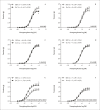Effects of Continuous and Accumulated Exercise on Endothelial Function in Rat Aorta
- PMID: 28538761
- PMCID: PMC5421470
- DOI: 10.5935/abc.20170036
Effects of Continuous and Accumulated Exercise on Endothelial Function in Rat Aorta
Abstract
Background:: The practice of exercise in short bouts repeated throughout the day may be an alternative strategy to lift people out of physical inactivity.
Objective:: to evaluate if accumulated exercise, as occurs in continuous exercise training, improve endothelial function in rat aorta.
Methods:: Wistar male rats were divided into three groups: continuous exercise (CEx, 1 hour on the treadmill) or accumulated exercise (AEx, 4 bouts of 15 minutes / day) for 5 days/week for 8 weeks, or sedentary (SED). During the training period, body weight gain and increase in exercise performance were recorded. On sacrifice day, aorta was dissected into rings (3-5 mm) and mounted on the organ bath.
Results:: Fitness was significantly greater in CEx and AEx rats as compared with SED animals. In addition, compared with the SED group, CEx animals had a lower body mass gain, and the aorta obtained from these animals had reduced contractile response to norepinephrine and greater acetylcholine-induced relaxation. These results were not observed in ACEx animals.
Conclusions:: Both CEx and AEx improved fitness, but only CEx led to reduced body weight gain and improved endothelial function.
Fundamento:: A prática de exercícios em sessões curtas que se repetem ao longo do dia pode ser uma alternativa para tirar as pessoas da inatividade física.
Objetivo:: Verificar se o exercício acumulado, tal como ocorre com o treinamento com exercício contínuo, melhora a função endotelial na aorta de ratos.
Métodos:: Ratos Wistar machos foram divididos em 3 grupos: treinamento com exercício contínuo (ExC; 1 hora em esteira) ou com exercício acumulado (ExA; 4 sessões de 15 minutos ao longo do dia) por 5 dias/semana, durante 8 semanas, ou grupo sedentário (SED). Durante o treinamento, foram registrados o ganho de peso corporal e desempenho na esteira. No dia do sacrifício, anéis (3-5 mm) da aorta foram obtidos e montados em banho de órgãos.
Resultados:: Animais ExC e ExA mostraram aptidão física significativamente maior em comparação com os SED. Paralelamente, em comparação com SED, animais ExC tiveram menor ganho de massa corporal, e aortas retiradas desses animais mostraram respostas contrácteis à noradrenalina reduzidas e maior relaxamento induzido pela acetilcolina. Esses resultados não foram observados no grupo ExA.
Conclusões:: Tanto o ExC quanto o ExA melhoraram a aptidão física, mas somente o ExC foi capaz de reduzir o ganho de peso corporal dos animais e melhorar a função endotelial.
Conflict of interest statement
No potential conflict of interest relevant to this article was reported.
Figures



Similar articles
-
Effects of a Single Bout of Resistance Exercise in Different Volumes on Endothelium Adaptations in Healthy Animals.Arq Bras Cardiol. 2017 May;108(5):436-442. doi: 10.5935/abc.20170060. Arq Bras Cardiol. 2017. PMID: 28591321 Free PMC article.
-
Ruthenium Complex Improves the Endothelial Function in Aortic Rings From Hypertensive Rats.Arq Bras Cardiol. 2017 Jun 29;109(2):0. doi: 10.5935/abc.20170090. Online ahead of print. Arq Bras Cardiol. 2017. PMID: 28678930 Free PMC article.
-
Resveratrol Treatment Normalizes the Endothelial Function and Blood Pressure in Ovariectomized Rats.Arq Bras Cardiol. 2017 Feb;108(2):116-121. doi: 10.5935/abc.20170012. Arq Bras Cardiol. 2017. PMID: 28327868 Free PMC article.
-
The role of physical exercise in obstructive sleep apnea.J Bras Pneumol. 2016 Nov-Dec;42(6):457-464. doi: 10.1590/S1806-37562016000000156. J Bras Pneumol. 2016. PMID: 28117479 Free PMC article. Review.
-
Cardiopulmonary Exercise Test: Background, Applicability and Interpretation.Arq Bras Cardiol. 2016 Nov;107(5):467-481. doi: 10.5935/abc.20160171. Arq Bras Cardiol. 2016. PMID: 27982272 Free PMC article. Review.
Cited by
-
Non-Pharmacological Treatment of Cardiovascular Disease | Importance of Physical Exercise.Arq Bras Cardiol. 2019 Aug 8;113(1):9-10. doi: 10.5935/abc.20190118. Arq Bras Cardiol. 2019. PMID: 31411288 Free PMC article. No abstract available.
-
Endothelial Progenitor Cells and Exercise: Working Together to Target Endothelial Dysfunction in Metabolic Syndrome.Arq Bras Cardiol. 2021 Jul;117(1):118-119. doi: 10.36660/abc.20210399. Arq Bras Cardiol. 2021. PMID: 34320080 Free PMC article. English, Portuguese. No abstract available.
-
Endothelial Function and Physical Exercise.Arq Bras Cardiol. 2018 Oct;111(4):540-541. doi: 10.5935/abc.20180211. Arq Bras Cardiol. 2018. PMID: 30365677 Free PMC article. No abstract available.
-
Impact of Lifestyles (Diet and Exercise) on Vascular Health: Oxidative Stress and Endothelial Function.Oxid Med Cell Longev. 2020 Sep 26;2020:1496462. doi: 10.1155/2020/1496462. eCollection 2020. Oxid Med Cell Longev. 2020. PMID: 33062134 Free PMC article. Review.
References
-
- Garber CE, Blissmer B, Deschenes MR, Franklin BA, Lamonte MJ, Lee IM, et al. American College of Sports Medicine American College of Sports Medicine position stand. Quantity and quality of exercise for developing and maintaining cardiorespiratory, musculoskeletal, and neuromotor fitness in apparently healthy adults: guidance for prescribing exercise. Med Sci Sports Exerc. 2011;43(7):1334–1359. - PubMed
-
- Haskell WL, Lee IM, Pate RR, Powell KE, Blair SN, Franklin BA, et al. Physical activity and public health: updated recommendation for adults from the American College of Sports Medicine and the American Heart Association. Med Sci Sports Exerc. 2007;39(8):1423–1434. - PubMed
-
- Rognmo Ø, Hetland E, Helgerud J, Hoff J, Slørdahl SA. High intensity aerobic interval exercise is superior to moderate intensity exercise for increasing aerobic capacity in patients with coronary artery disease. Eur J Cardiovasc Prev Rehabil. 2004;11(3):216–222. - PubMed
-
- Tordi N, Mourot L, Colin E, Regnard J. Intermittent versus constant aerobic exercise: effects on arterial stiffness. Eur J Appl Physiol. 2010;108(4):801–809. - PubMed
MeSH terms
Substances
LinkOut - more resources
Full Text Sources
Other Literature Sources
Medical
Miscellaneous

